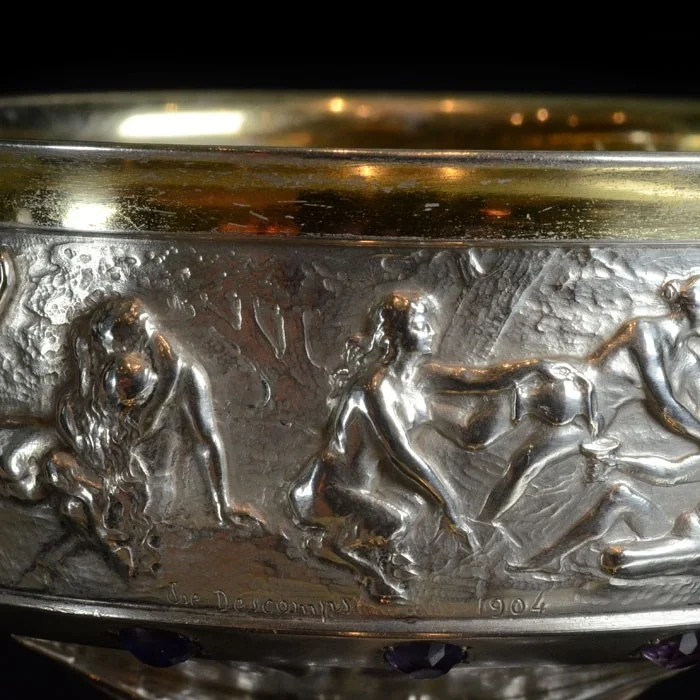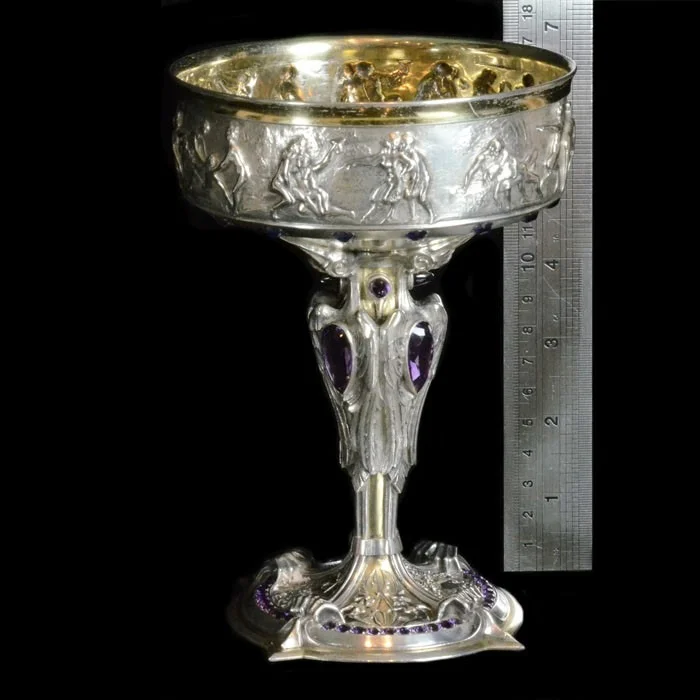1904 Descomps Decorative Silver & Amethyst Goblet




1904 Descomps Decorative Silver & Amethyst Goblet
1904
An unusual and highly decorative silver, silver-gilt and amethyst goblet.
Price: £25,000.00
A silver, silver-gilt and amethyst goblet by Descomps, 1904, the unusual decorative silver goblet with a Grecian design frieze featuring Dionysus with frolicking Maenads and Satyrs to a stem formed of four storks, their heads supporting the bowl, their wings and legs forming the stem which is embellished with pear-shaped amethysts and their feet the base, decorated with four naturalistic pictorial scenes, the underside of the cup and base embellished with round amethysts and pastes.
- Origin: Paris, France
- Gemstones and Other Materials: 56 circular-cut amethysts 16.80cts approx 4 cabochon amethysts 4.00cts approx 4 pear-shape amethysts 35.00cts approx
- Condition Report: Loss of gilding, minor scuffs to metalwork as commensurate with age, clear signature and date, residue from previous cleaning visible around some of the amethysts, overall in good condition.
- Setting: Silver signed Joe Descomps 1904 and with French assay mark and maker's mark for Descomps on the bowl and maker's mark for Jean-Baptiste François on the foot
- Weight description: 738 grams
- Dimensions: 17.40cm x 12.00cm 6.90" x 4.70"
Joe Descomps
1872-1948
Emanuel Jules Joseph Descomps was a French sculptor and jeweller working in Paris during the late 19th and early 20th Centuries. Known as Joë he is best remembered for his Art Nouveau figurines of women which were often modelled in bronze and ivory.
He received his early training at Alexandre Falguières under H. Hiolin, an engraver and metal designer. He was a member of the French Society of Artists and in 1898 he received an honourable mention for two small statues and three gold brooches. He was also an accomplished silversmith and jeweller creating pieces such as the beautiful gold and plique-à-jour enamel Art Nouveau pendant which is in the collection of the Victoria & Albert Museum. Depicting a female figure standing amongst trees, it is set with a peridot and decorated with white, yellow and brown diamonds.
Two further pendants are illustrated in Henri Vever’s renowned tome French Jewellery of the 19th Century, a striking Druidess pendant in chased gold and enamel suspending a pearl and another set with a carved ivory plaque depicting a flute playing nymph. His jewellery often depicted sculpted female forms within naturalistic floral and pastoral settings in keeping with the prevailing Art Nouveau style of the period.
In 1900 he moved premises from 399 Rues de Pyrénées to 37 Rue de Moulin-Vert and in 1908 participated in an exhibition at the Museum Galliera entitled “Precious Head Ornaments”. Descomps passed away in 1948.